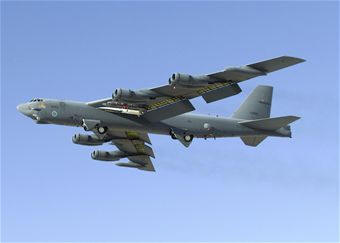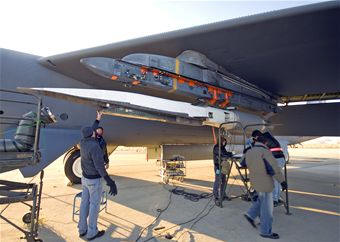
NEWSROOM
 |
NEWSROOM |
|
|
|
|
|||
|
X-51A
WaveRider Gets First Ride Aboard B-52 By Derek Kaufman |
||||
 |
December 12, 2009
- The X-51A Waverider was carried aloft for the first time December 9,
2009, by an Air Force Flight Test Center B-52 Stratofortress over
Edwards Air Force Base,
"This was a great
day for the program," said Charlie Brink, X-51A program manager with the
Air Force Research Laboratory at Wright-Patterson AFB, The Dec. 9 test, reminiscent of the early days of the historic X-15 program 50 years earlier, was conducted entirely in the airspace over Edwards AFB while various systems and telemetry were checked out. The Flight duration was 1.4 hours.
"After takeoff we
climbed to 50,000 feet and verified B-52 aircraft performance, handling
qualities with the X-51A attached to the B-52, control room displays and
software integration with the X-51A," said Lt. Col. Daniel Millman, a
B-52 project pilot. "The B-52 handled great and the flight preceded as
planned."
The next B-52/X-51
flight test mission is expected in mid-January, and will be a full dress
rehearsal, for its first hypersonic test flight, now planned for
mid-February, Mr. Brink said. The dress rehearsal flight will depart
Edwards AFB and head out over the Pacific to
In February, the
Air Force Flight Test Center's B-52 will carry the unmanned X-51A to
approximately 50,000 feet over the |
|||
| An Air Force Flight Test Center B-52H Stratofortress performs a captive carry flight of the X-51A WaveRider Dec. 9, 2009, over Edwards Air Force Base, Calif. The captive carry mission is a key test milestone to ready the X-51's scramjet engine during the vehicle's first powered hypersonic flight in early 2010 | ||||
 |
||||
| Crewmembers and program officials prepare the X-51A WaveRider for a captive carry flight under an Air Force Flight Test Center B-52H Stratofortress Dec. 9, 2009, at Edwards Air Force Base, Calif. The captive carry mission is part of preparations being made prior to the X-51's first powered hypersonic flight in early 2010. | ||||
|
Four X-51A
cruisers have been built and were developed by officials from the Air
Force, Defense Advanced Research Projects Agency, Pratt & Whitney
Rocketdyne and Boeing.
As the engine ignites it will initially burn a mix of ethylene and JP-7
fuel before switching exclusively to JP-7. The X-51's fuel-cooled engine
design will both heat the JP-7 to an optimum combustion temperature and
help the engine itself endure extremely high operating temperatures
during the long burn.
Boeing's Phantom Works performed overall air vehicle design, assembly
and testing for the X-51's various components.
Mr. Vogel called the mission an essential step to ready for the dress
rehearsal, where the team will run through the processes of a complete
mission profile in final preparation for the X-51's first powered flight
early next year.
Program officials said the scramjet motor's great advantage is the
ability to capture and burn oxygen in the thin atmosphere, rather than
having to carry it in a large tank like the space shuttle or other
rockets. Not having to carry the oxidizer needed for combustion means
more payload capability. Beyond scalable scramjet propulsion, other key
technologies that will be demonstrated by the X-51A include thermal
protection systems materials, airframe and engine integration, and
high-speed stability and control.
Boeing officials said they also had to demonstrate the X-51A 's
compatibility with the electromagnetic environment of the B-52H
aircraft. The test verified that the X-51A can be powered by and
communicate with the B-52H using a modified Joint Direct Attack Munition
interface. "Adapting existing, proven hardware, helps us keep program
costs down," Mr. Brink said. |
| ?AvStop Online Magazine Contact Us Return To News |
|